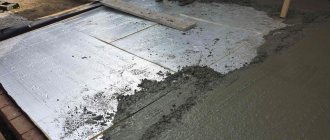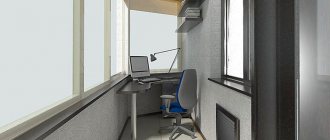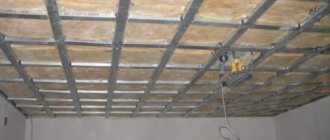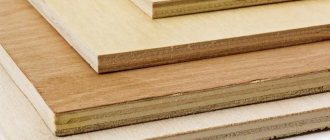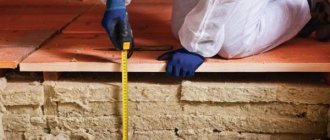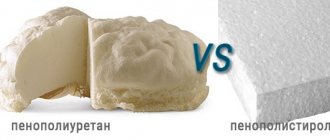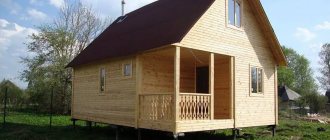The modern market of construction materials offers a significant range of different insulation materials, differing in degree of efficiency. One of the representatives of the new generation of heat insulators can be called penofol. With its help, you can easily insulate any surface in the house, be it the ceiling, walls or floor. Due to the fact that this material is produced using a special technology, it has high heat-saving qualities and other valuable characteristics.
Expert opinion
Konstantin Alexandrovich
A special production technology gives this material high thermal insulation properties and other characteristics. The article widely covers its main properties, discusses the scope of application, and describes in detail the process of floor insulation with penofol.
Characteristics
This material surprises with its scope of application. They can insulate absolutely the entire house. This coating is made from polyethylene. The production technology is that polyethylene is coated with special reagents that foam. The mixture is applied to a foil base. The coating hardens, providing reliable adhesion.
The foil base only enhances the thermal insulation. This process occurs due to the fact that heat waves are reflected inside the building.
The most important characteristics:
- Penofol is small in thickness. It has high thermal insulation rates. The material is excellent for insulating small rooms in which it is not possible to lay a bulk layer of thermal insulation material.
- A distinctive feature of penofol is its versatility. It is widely used as a waterproofing agent. Also suitable for providing vapor barrier.
- It combines well with other materials and even enhances their properties.
- This product is produced using the most modern technologies. The material has a long service life. Various harmful additives are not used in production. The product is environmentally friendly and does not harm human health.
- Has good resistance to various weather conditions. Can be used at low temperatures. The minimum operating temperature is minus 55 degrees. Penofol will be difficult to melt, even at a temperature of +110 degrees.
- Insulating the floor with penofol is easy. The material is easy to install. Its prices are pleasantly surprising.
Choosing a heat insulator
If we are talking about thermal insulation, then you should not save on insulation. You should purchase only high-quality materials for floor insulation in a wooden house.
Ideally, the floor temperature in the room should be slightly lower than the general temperature. Therefore, if low-temperature coatings are used, condensation may form on them.
Rolled mineral wool.
As a result, a humid environment promotes the growth of mold and mildew. In addition, a good thermal insulator must have high compressive strength and low density during deformation, since most mechanical loads will fall on it.
Types of thermal insulation materials
Insulating a wooden floor in a private house requires the installation of high-quality insulation, since there are always small gaps between the boards through which the cold penetrates into the room. Therefore, the insulation must be laid in a continuous layer.
Today the following materials have the best characteristics:
- Styrofoam. For a long time, this material has been the leader in the heat insulator market. Today, the main competitor of polystyrene foam is mineral wool, which has several important advantages over this material.
The main advantages of polystyrene foam
- Excellent thermal insulation.
- Biological stability.
- Stability of shape and volume.
- High moisture resistance.
- Low vapor permeability.
- Easy to install with your own hands.
- Environmentally friendly, does not emit harmful substances into the environment.
Styrofoam.
Flaws
- Poor sound insulation.
- Service life is no more than 20 years.
- It is flammable and releases harmful substances when burned.
- Acceptable price.
- Wide range of sizes. In addition, there is both slab and more flexible rolled material.
- Excellent heat and sound insulation.
- Fire safety.
- Easy to install.
- Service life is about 30 years.
- Mineral wool. Very often, the insulation of the floor of a wooden house is made with this material. Moreover, in addition to floor coverings, mineral wool is also used for walls, ceilings, balconies, etc., since it is a universal heat insulator.
Advantages of mineral wool
Slab mineral wool.
- Penofol is a thin insulation material that has unique properties. Due to the presence of a foil side, this material can be used as a waterproofing material, while possessing high thermal insulation characteristics. Penofol insulation is most often used in cases where it is necessary to lay as thin a layer of thermal insulation as possible (internal wall insulation). As a replacement for this heat insulator, insulation is often carried out with isolon, which has similar characteristics.
Penofol structure.
Where is penofol used?
This material is good for use in insulating rooms, as well as for vapor barrier. It is common to insulate the floor with penofol in a wooden house. After the work is completed, the heat is reliably retained in the room, providing comfort. In multi-storey buildings, it is often common to insulate the floor on the loggia with penofol. It is appropriate to use it when combining a loggia with a living room and want to achieve the effect of a warm floor throughout the apartment.
In addition to wall insulation, penofol is also used for ceilings. They install thermal insulation in the air duct. The material is suitable for use in pipelines. It is even used in the automotive industry, at the stage of thermal insulation of the car body.
Errors
If we insulate the floor and ceilings correctly, this will ensure a long service life of all materials used without any unpleasant stories in the form of moisture accumulation or cold penetration. A typical mistake made by beginners is inattention when following the stages of laying materials, which can lead to their premature wear and the need to start all over again.
To prevent this from happening, it is important not to forget which layer of the “pie” follows which, especially if a novice master is doing this for the first time in his life
If you want to provide not only thermal insulation, but also enhance the sound-absorbing properties of the “insulation pie,” it is important not to forget to add two plywood layers to it, which will ensure the creation of a good sound barrier. If expanded clay is used as the main material, during the course of work it will be necessary not to lose sight of an important part of the structure in the form of a concrete screed, which will prevent its premature shrinkage and protect it from excessive moisture absorption
How can you insulate a wooden floor using penofol?
Older private homes usually have wood floors. Over time, they begin to retain heat poorly, and the room becomes cold. It is especially difficult for residents in the autumn and winter periods. There is a simple method to correct the current situation with the floor. It is possible to insulate a wooden floor with penofol without opening it. Thermal insulation material is laid on top. It turns out that the layer is located on top of the wooden floor. It is placed end to end. It is important not to forget that the seams must be sealed with special aluminum tape.
The resulting layer is covered with sheets of plywood. Thermal insulation is attached to the wooden base using self-tapping screws.
Insulation of a wooden floor with penofol from below occurs by raising the upper boards. It is preferable to remove the old covering from the boards and put several layers of covering between the joists. The material must be laid with the foil down. After this, the old coating is returned to its place.
Insulating the floor from below with penofol is a convenient way to work with this material. The floors will definitely become warmer.
Insulation from below
When insulating the floor in a one-story wooden house or on the first floor, it is important to ensure good thermal protection of the subfloor before laying any fashionable coating (linoleum, laminate, tile) on the outside of the boards. First, you need to lay a waterproofing film over the entire area of the concrete floor slab so that moisture from below does not enter the area of the future insulation
All other work is carried out on top of the film - wooden logs, the insulation itself and a vapor barrier layer are laid, which should be overlapped (from 15 to 20 cm). The thickness of the insulation for the first floor is usually 3-5 cm.
From below, from the underground, you can also insulate the floor, which will ensure dryness and maximum heat retention in the house without unnecessary heat leaks. In theory, the floors should be insulated before finishing, but if this is not possible, there is always the option of insulating the floor from below without disassembling the boards. The material most often used is dense blocks of mineral wool. Its average thickness is 150 mm. When working, long self-tapping screws (from 180 mm) are used with the expectation that they will attach the insulation to the board.
All work is carried out using a screwdriver. Since mineral wool is a very dense material, installation of such insulation is very easy. The main thing is to do everything as tightly as possible, and after finishing the main work, you can cover the finished structure with a membrane or wind protection in the form of a special film for insulation. In order to protect the material as much as possible from the influence of the external environment, you can carry out additional cladding with boards, if the underground room allows this.
In the same way, you can insulate the finished floor on the veranda, if it is already ready and there is space under it in which the master can fit. Since it is very easy to work with mineral wool, it is always the optimal solution in situations where there is no opportunity or desire to dismantle the floors and lay them again. And even if we are talking about a country house, which, it would seem, can no longer be improved, insulating the floor from the inside with your own hands can be done in exactly the same way. Mineral wool, due to its density, perfectly retains heat, which will create additional comfort and advantages for the owners of an old country house.
Using penofol on concrete floors
Floor insulation in a private house with penofol is widely used even on a concrete base.
To get a high-quality coating, you need to perform the work sequentially:
- The concrete surface is leveled. It must be cleaned of all kinds of contaminants. It is better to use a self-leveling screed. Some people prefer a self-leveling mixture.
- Penofol is placed on the resulting flat surface. It is recommended to choose class “B”, where there is foil on each side. It is necessary to make high-quality joints, and then close them with aluminum tape.
- The next step in insulating the floor with penofol will be the installation of a wooden frame. The cross-section of the timber used must be at least 5.5 centimeters
- Insulation is selected and placed in a wooden frame. It must be compressed with mineral wool. It is possible to use polystyrene foam.
- Next, a second layer of penofol is laid. For this stage, you can take class “A” of the desired product, which has foil on only one side.
- The final stage of insulation will be the installation of boards that are laid on top of wooden logs.
Nuances of fastening and installation
When laying foil insulation, you may need the following tools and materials:
- nails with large heads;
- stapler;
- hammer;
- construction tape.
When installing insulation with foil, it is important to avoid the mistake of laying the material with the shiny side down. In this case, the material will not perform its heat-reflecting functions. The foil side must “look” into the room in order to be able to return thermal energy to the room.
An example of laying lag on foil insulation
Advice! You can leave a small air gap between the insulation and the floor covering. Then the floors will be even warmer.
It is also important to remember that the insulation does not overlap. The sheets should be placed end to end and secured with tape or nails, depending on the type of base. Insulation with an adhesive layer may not be additionally fixed, but it is still recommended to secure it with fastening materials. All joints after laying the material are taped.
Thermal insulation for heated floors
Work on laying insulation can be dry or wet. In the second case, the material will be filled with concrete screed. In the first one, it is advisable to install an additional waterproofing layer.
Pros of using penofol
It is important to know all the positive aspects of using this material:
- It can be laid in rooms where it is damp, for example, in a cellar (basement). When laying, separate membranes for waterproofing are not required.
- In addition to the fact that you get a coating that retains heat well, sound insulation is a bonus. This quality of material is relevant for multi-storey buildings with noisy neighbors.
- Penofol is recommended to be used in combination with other heat insulators, then its properties only increase. A good example is the use of the desired material in baths. A layer of aluminum foil in the steam room helps keep the temperature high.
- Even at high humidity and high temperatures, penofol will not emit fumes that could harm human health.
- The material is considered thin, which is good when laying it on the ceiling. The height of the ceilings practically does not change; other insulation materials make the room visually smaller, since they recede a few centimeters from the ceiling.
- Penofol is offered for sale in rolls. It can be easily cut and you can lay it down in a short period of time.
- It is often used in areas where there is a high fire hazard. The material does not burn, which makes it irreplaceable.
- For private houses, it is used to insulate the basement floors, and also because mice do not gnaw on it.
Disadvantages of insulation
Penofol has much fewer disadvantages than advantages. Its price is slightly higher than that of other insulation materials. Penofol is not always enough to retain heat; you often have to use several materials at the same time.
The use of additional adhesive liquids will help to evenly fix the material during installation. They slightly increase the cost of the project.
It is difficult to lay a heat-insulating foam foam coating on the floor yourself, because the slightest technological errors can cause a strong decrease in the room temperature. Before work, study in detail all the nuances of the project and take the task seriously.
Reviews from private home owners
Home owners respond positively to this material. Citizens note that they choose floor insulation with penofol because of its lightweight technology. The work can be done with your own hands, the main thing is to follow the instructions for use.
Many note the durability of the desired material. It is difficult to make a mistake when insulating a surface, even when sealing joints. Penofol also received positive reviews due to its low cost. Compared to other insulation materials, it has an affordable price for most citizens.
So, we found out what penofol is and how to insulate rooms with it.
The need for such work
Disputes about whether it is necessary to put insulation under linoleum on a concrete floor have been taking place since the time when this material first appeared on the construction market. Of course, if you lay an underlay under the coating, the floor will become much warmer. Insulation should be done for a number of reasons:
- Anyone who lives on the ground floor knows for certain that even linoleum with insulation does not solve the problem associated with cold floors. Do not forget that the floor is on a concrete base, and underneath there is a basement that is not heated. Then felt insulation is a must. It is better if major insulation is carried out using polystyrene foam or styrofoam;
- Another reason is the insufficient size of reinforced concrete floors;
- It is no secret that linoleum should be laid on a perfectly flat surface. The floors in modern apartments are far from ideal in this regard. Therefore, by laying the substrate, this disadvantage can be somewhat corrected.
Insulation with electric cable
Heating is provided for 30% of the area, this is enough for an apartment with a centralized supply of hot water. When drawing up a cable layout, exclude places under the closet, wardrobe, bed and similar objects. More often, this type of floor heating is done in the bathroom, toilet and kitchen, with a floor covering made of tiled material.
For dry rooms, energy consumption per square meter per hour is 120 W/, with high humidity - 140 W. For example, for a room of 6 m2 you need 720 W/hour.
The thermostat is placed at a distance of 30 centimeters from the flooring. If it is electronic, then you need to install it higher.
The cable is distributed evenly on the foil-insulating material over the entire area of the site, observing a step of 20 to 40 centimeters. The brought out ends are connected to a power source. The maximum cable length should not exceed 6 meters.
After checking the functionality of the entire system, it is filled with concrete mixture. Bubbles from the inside are removed using the rules for leveling the solution (needle roller).
Note: You can use an electric floor in mats, which will significantly reduce the installation time.
Useful installation video
Rules for laying foil backing
Foil underfloor heating can be in rolls, mats or slabs. When laying, this coating must be joined both in length and width. In order for the connections to have the same properties, the fragments are glued together with special metallized (foil) tape. You must glue carefully, avoiding gaps, try to make the fit as precise as possible, without gaps.
When laying thin rolled foil material in a screed, the strips may overlap one another. The size of this “overlap” is at least 10 cm. This joint is glued twice on one side and on the other. We make cross connections according to the same rules.
It is recommended to use foil tape for connection.
When laying mats or slabs, they are joined close to one another, then glued with the same shiny tape. Some manufacturers make a lock along the edges of the slabs, which reduces the possibility of heat leakage through the joints. Despite this, we also glue the locking joints with tape. This makes it much more reliable.
Electrical
Modern manufacturers of electrical equipment answer the question of how to heat the floor under linoleum. The desired microclimate is created not by retaining heat, but by additional energy expenditure. The cost of the device is determined by the complexity of the technology used.
Film heated floor
The heating element is produced in the form of sheets. The canvas is laid on a heat-reflecting layer and runs on mains power. Low-power thermal film (up to 150 W/m2) continuously maintains a comfortable floor temperature and prevents overheating.
Infrared
Transparent polyester fabric is fire resistant and moisture resistant. The heating element is mounted directly under the linoleum without the use of cement or putty. This type of insulation is recommended for loggias, where it is effective and safe.
Infrared film floor
Electric
This heating method is suitable for any type of flooring except parquet. Heating cables are laid on the thermal insulation material, and a thermostat is mounted against the wall. The entire system is connected to the electrical network. After the inspection, the structure is filled with cement and linoleum is laid.

